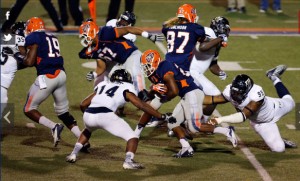Youth football injuries can stay with children well after wins and losses
|
As a football player, Ed Stansbury led El Paso’s Irvin High School to four district championships, was named MVP by the El Paso Times and the El Paso Herald-Post, won a bowl game with UCLA and then went on to play three years in the NFL for the Houston Texans and Seattle Seahawks. But he said if he had the choice to do it all over again and relive his glory days on the field, he probably wouldn’t. “I’ve been 10 years away from football, but it’s now that I’m feeling all the effects,” Stansbury said. “I read about the symptoms that I’m suffering from now—loss of memory, short-term memory, things aren’t coming to me as quick anymore and I blank out sometimes.”
Now, Stansbury is the director of operations for the Greater El Paso Football Showcase, where he gives speeches to El Paso football players and helps them along the way in their careers. He also provides expert analysis for high school football on KTSM Channel 9’s Overtime show.


